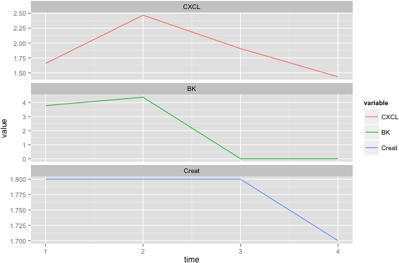Urinary CXCL9 Protein as Biomarker for BK Polyoma Viremia.
1Division of Nephrology, University Hospitals Case Medical Center, Case Western Reserve University, Cleveland, OH
2Comprehensive Transplant Center, Northwestern University Feinberg School of Medicine, Chicago, IL.
Meeting: 2016 American Transplant Congress
Abstract number: D228
Keywords: Graft failure, Infection, Kidney transplantation, Nephropathy
Session Information
Session Name: Poster Session D: Polyomavirus
Session Type: Poster Session
Date: Tuesday, June 14, 2016
Session Time: 6:00pm-7:00pm
 Presentation Time: 6:00pm-7:00pm
Presentation Time: 6:00pm-7:00pm
Location: Halls C&D
Introduction: BK infection is common in kidney transplant patients and can result in accelerated loss of allografts. Management involves empiric lowering of immunosuppression, which can result in rejection. In this study, we explored urine CXCL9 as a biomarker of BK nephropathy.
Methods: Urines were collected in 20 patients, at 1, 3, 6, and 12 months post transplant. If a patient was found to have BK viremia, we collected urines every month for 6 months from the time of detection of BK viremia. Urine supernatant was used for measuring CXCL9 by ELISA. Linear regression analysis was done if BK viremia significantly predicted CXCL9 level.
Results:We had 20 post-kidney transplant patients who had their urine CXCL9 measured at various intervals. 6 of them had detectable BK viremia, and 14 were controls that were negative for BK or rejection or UTI. Baseline characteristics of the patients are shown in the table below. There were no significant differences in the mean age, gender, HLA mismatch, living donor percent, and thymoglobulin induction in both the groups.
Exploratory analysis of our main outcome variable CXCL9 revealed that it was right skewed, and hence a log (CXCL9) was used for further statistical analyses to allow for application of parametric methods. Mean of the CXCL9 in BK group, and control group were 49.2, and 14.2 respectively (p-value <0.05). A linear model between CXCL9 and BK load resulted in the following equation. This model had a p-value of <0.01, suggesting that BK viral load is a significant predictor of urine CXCL9.
CXCL9= 4.5+1.2(log BK load)
Figure below illustrates CXCL9, BK viral load, and Serum Creatinine trend in a patient over the period of three months from detection of BK viremia on routine monitoring  .
.
Conclusion: CXCl9 is useful biomarker of BK nephropathy, and it's utility in tailoring of immunosuppression needs to be further explored.
CITATION INFORMATION: Sarabu N, El-Rifai R, Augustine J, Padiyar A, Huml A, Young T, Rodriguez V, Hricik D. Urinary CXCL9 Protein as Biomarker for BK Polyoma Viremia. Am J Transplant. 2016;16 (suppl 3).
To cite this abstract in AMA style:
Sarabu N, El-Rifai R, Augustine J, Padiyar A, Huml A, Young T, Rodriguez V, Hricik D. Urinary CXCL9 Protein as Biomarker for BK Polyoma Viremia. [abstract]. Am J Transplant. 2016; 16 (suppl 3). https://atcmeetingabstracts.com/abstract/urinary-cxcl9-protein-as-biomarker-for-bk-polyoma-viremia/. Accessed December 13, 2025.« Back to 2016 American Transplant Congress
